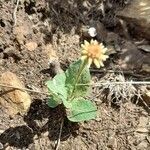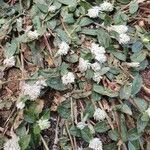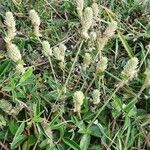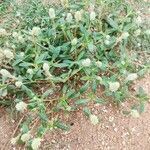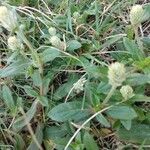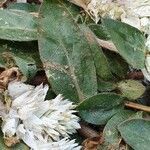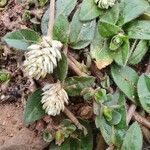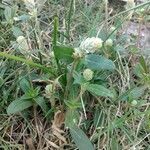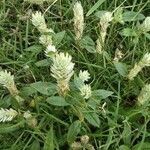Perennial herb, 0.3-1.5 m high, erect, prostrate, ascending 70-300 mm, much branched from base, usually thickened at nodes, pubescent. Leaves opposite, sessile or subsessile, entire, narrowly oblong to oblong-elliptic. Inflorescences terminal or axillary, capitate, finally elongate and cylindrical, 40-70 mm long. Flowers bisexual, solitary in axils of bracts; bracts deltoid-ovate, 2.5-4.0 mm long. Flowering time Jan.? Seed compressed-ovoid, brown, smooth or faintly reticulate, shining.
Herbs annual, erect. Stem white villous. Petiole 1-1.5 cm, long gray hairy; leaf blade oblong or oblong-obovate, papery, long white hairy and ciliate, narrowing toward base, margin undulate, apex acute or obtuse. Heads silvery; bracteoles purple, triangular-lanceolate, much longer than bracts. Tepals rigid after anthesis. Filaments connate into a tube, 5-parted at apex. Styles linear, shorter than tube of stamens; stigmas 2, furcate. Utricles subglobose. Fl. and fr. Feb-Jun. 2n = 26.
Perennial herb, up to 0.35 m high. Stems procumbent, decumbent or erect; much branched; white silky hairy. Leaves opposite; blade elliptic to obovate, 15-45 x 5-13 mm, decurrent, apex acute, margins entire, upper surface glabrous to thinly pilose, lower surface thinly to densely hairy with long, whitish hairs. Flowers: inflorescence terminal, sessile above uppermost pair of leaves, globose to spicate as flowers mature; bracteoles membranous; perianth 5-6 mm long, white; Oct.-Jun.
A herb. It can lie along the ground or be erect. It grows each year from seeds. It can keep growing for several years. It forms mats. It has an unpleasant smell. It grows 10-30 cm high. It has long silky hairs. The stems are angled. They branch and are red and hairy. The leaves are opposite and hairy. The flowers form round heads. They have papery white bracts.
Prostrate, decumbent or erect herb, up to 350 mm tall. Stems with white silky hairs. Leaves lanceolate to elliptic. Inflorescences terminal, globose to spicate as flowers mature. Flowers 5 or 6 mm long, bracteoles papery; white.
